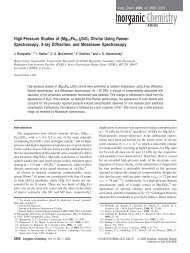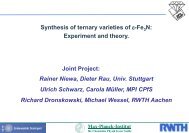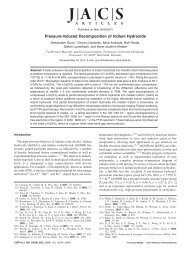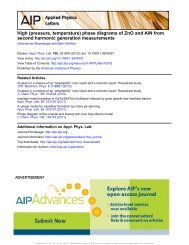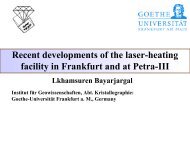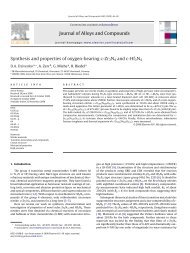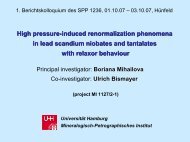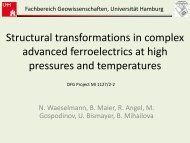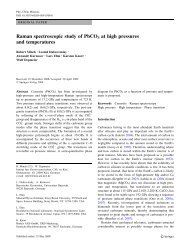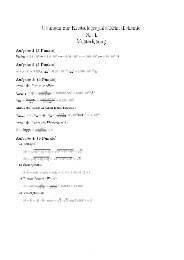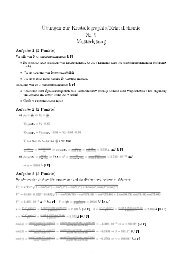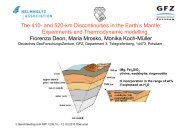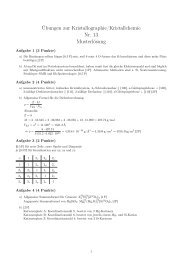In situ observation of the reaction of scandium and carbon by ...
In situ observation of the reaction of scandium and carbon by ...
In situ observation of the reaction of scandium and carbon by ...
Create successful ePaper yourself
Turn your PDF publications into a flip-book with our unique Google optimized e-Paper software.
Journal <strong>of</strong> Alloys <strong>and</strong> Compounds 509 (2011) 1–5<br />
Contents lists available at ScienceDirect<br />
Journal <strong>of</strong> Alloys <strong>and</strong> Compounds<br />
journal homepage: www.elsevier.com/locate/jallcom<br />
<strong>In</strong> <strong>situ</strong> <strong>observation</strong> <strong>of</strong> <strong>the</strong> <strong>reaction</strong> <strong>of</strong> <strong>sc<strong>and</strong>ium</strong> <strong>and</strong> <strong>carbon</strong> <strong>by</strong> neutron diffraction<br />
Erick A. JuarezArellano a,b,∗ , Bjorn Winkler a , Sven C. Vogel c , Anatoliy Senyshyn d,e ,<br />
Daniel R. Kammler f , Miguel AvalosBorja g,1<br />
a <strong>In</strong>stitut für Geowissenschaften, Universität Frankfurt, Altenhöferallee 1, 60438 Frankfurt a.M., Germany<br />
b Universidad del Papaloapan, Circuito Central 200, Parque <strong>In</strong>dustrial, Tuxtepec 68301, Mexico<br />
c Los Alamos National Laboratory, Lujan Center. Mail Stop H805, Los Alamos, NM 87545, USA<br />
d Forschungsneutronenquelle Heinz MaierLeibnitz (FRM II), Technische Universität München, Lichtenbergstr. 1, D85747 Garching, Germany<br />
e Materialwissenschaft, TU Darmstadt, Petersensstr. 23, D64287 Darmstadt, Germany<br />
f S<strong>and</strong>ia National Laboratories, Albuquerque, NM 87185, USA<br />
g CNyN, UNAM, A. Postal 2681, Ensenada, B.C., Mexico<br />
article info<br />
Article history:<br />
Received 18 April 2010<br />
Received in revised form 11 August 2010<br />
Accepted 24 August 2010<br />
Keywords:<br />
Sc<strong>and</strong>ium carbide<br />
Neutron diffraction<br />
1. <strong>In</strong>troduction<br />
abstract<br />
<strong>In</strong> comparison to most o<strong>the</strong>r transition metal carbides, which<br />
are an interesting class <strong>of</strong> materials with very attractive properties<br />
[1], <strong>the</strong> formation <strong>of</strong> <strong>sc<strong>and</strong>ium</strong> carbides has not been studied<br />
extensively. Phases reported in <strong>the</strong> Sc–C system include cubic<br />
ScC (NaClstructure type (B1), a ≈ 4.51 ˚A [2,3]), cubic ScC 0.3–0.5<br />
(NaClstructure type (B1), a ≈ 4.7 ˚A [4]), cubic Sc 2C 3 (Pu 2C 3type<br />
structure, a = 7.205 ˚A [4]), cubic Sc 4C 3 (Th 3P 4structure type,<br />
a = 7.207 ˚A [5]), cubic Sc 13C 10 (unknown structure type, a = 8.53 ˚A<br />
[6]) <strong>and</strong> tetragonal Sc 3C 4 (P(4/m)nc, a = 7.4873 ˚A, c = 15.026 ˚A [7]).<br />
<strong>In</strong> a previous study, we have shown, based on DFT results, that Sc 2C 3<br />
is unlikely to exist <strong>and</strong> that <strong>the</strong> sample studied was probably Sc 4C 3<br />
[8].<br />
However, despite <strong>the</strong> studies mentioned above, it is probably<br />
fair to say that <strong>the</strong> Sc–C system has not been fully explored yet.<br />
Specifically, <strong>the</strong>re have been no high temperature in <strong>situ</strong> investigations<br />
at ambient pressure <strong>and</strong>, hence, <strong>the</strong> possible formation <strong>of</strong><br />
intermediate products during <strong>the</strong> syn<strong>the</strong>sis process has not been<br />
investigated. Also, no information related to accurate formation<br />
temperatures is available. <strong>In</strong> this work we followed <strong>the</strong> <strong>reaction</strong><br />
∗ Corresponding author at: <strong>In</strong>stitut fur Geowissenschaften, Universitat Frankfurt,<br />
Altenh<strong>of</strong>erallee 1, 60438 Frankfurt a.M., Germany.<br />
Email address: eajuarez@unpa.edu.mx (E.A. JuarezArellano).<br />
1 On sabbatical leave at IPICyT, San Luis Potosi, Mexico.<br />
09258388/$ – see front matter © 2010 Elsevier B.V. All rights reserved.<br />
doi:10.1016/j.jallcom.2010.08.081<br />
The formation <strong>of</strong> <strong>sc<strong>and</strong>ium</strong> carbides <strong>by</strong> <strong>reaction</strong> <strong>of</strong> <strong>the</strong> elements has been investigated <strong>by</strong> in <strong>situ</strong> neutron<br />
diffraction up to 1823 K. On heating, <strong>the</strong> recrystallization <strong>of</strong> Sc occurs between 1000 <strong>and</strong> 1223 K.<br />
The formation <strong>of</strong> Sc2C <strong>and</strong> ScC (NaClB1 type structure) phases has been detected at 1323 <strong>and</strong> 1373 K,<br />
respectively. The formation <strong>of</strong> a new orthorhombic <strong>sc<strong>and</strong>ium</strong> carbide phase was observed at 1473(50) K.<br />
Once <strong>the</strong> <strong>sc<strong>and</strong>ium</strong> carbides are formed <strong>the</strong>y are stable upon heating or cooling. No o<strong>the</strong>r phases were<br />
detected in <strong>the</strong> present study, in which <strong>the</strong> system was always <strong>carbon</strong> saturated. The <strong>the</strong>rmal expansion<br />
coefficients <strong>of</strong> all phases have been determined, <strong>the</strong>y are constant throughout <strong>the</strong> temperature interval<br />
studied.<br />
© 2010 Elsevier B.V. All rights reserved.<br />
<strong>of</strong> nominally pure Sc <strong>and</strong> C from <strong>the</strong> elements through in <strong>situ</strong> neutron<br />
diffraction measurements, in order to better underst<strong>and</strong> <strong>the</strong><br />
formation process.<br />
2. Experimental<br />
2.1. Sample<br />
Cryogenic milled <strong>sc<strong>and</strong>ium</strong> metal pieces with a nominal purity <strong>of</strong> 99.7 wt.% (Alfa<br />
Aesar in Ward Hill) <strong>and</strong> graphite (20 m grain size) were used in this study. Both<br />
materials were previously characterised <strong>by</strong> Kammler et al. [9] (Sc) <strong>and</strong> Winkler et al.<br />
[10] (graphite). <strong>In</strong> all <strong>the</strong> experiments an excess <strong>of</strong> <strong>carbon</strong> was used. Additional sample<br />
characterisation was performed using electron energy loss spectroscopy (EELS)<br />
at <strong>the</strong> <strong>In</strong>stitute for Scientific <strong>and</strong> Technological Research <strong>of</strong> San Luis Potosi (IPICyT)<br />
in San Luis Potosi (Mexico) with a Gatan image filter system mounted on a Tecnai<br />
G2 F30 operated at 300 kV, with a sphericalaberration coefficient (Cs) <strong>of</strong> 1.2 mm.<br />
2.2. <strong>In</strong> <strong>situ</strong> neutron diffraction<br />
To investigate <strong>the</strong> <strong>reaction</strong> <strong>of</strong> <strong>sc<strong>and</strong>ium</strong> <strong>and</strong> <strong>carbon</strong> <strong>by</strong> neutron diffraction<br />
two different syn<strong>the</strong>sis conditions were used. On one h<strong>and</strong>, <strong>the</strong> temperature was<br />
increased systematically up to temperatures above <strong>the</strong> <strong>sc<strong>and</strong>ium</strong> melting point<br />
(1823 K) in order to get <strong>the</strong> <strong>sc<strong>and</strong>ium</strong> reacted completely. While on <strong>the</strong> o<strong>the</strong>r h<strong>and</strong>,<br />
once <strong>the</strong> onset <strong>of</strong> <strong>the</strong> <strong>reaction</strong> <strong>of</strong> <strong>sc<strong>and</strong>ium</strong> <strong>and</strong> <strong>carbon</strong> was detected, <strong>the</strong> temperature<br />
was kept constant in order to see <strong>the</strong> <strong>the</strong>rmal stability <strong>of</strong> <strong>the</strong> first formed<br />
phases (HIPPO). Powder neutron diffraction measurements were performed with<br />
SPODI [11] diffractometer at <strong>the</strong> FRMII reactor (Garching, Germany) <strong>and</strong> with <strong>the</strong><br />
HIPPO time<strong>of</strong>flight diffractometer [12] at <strong>the</strong> Lujan Center at Los Alamos [13]. For<br />
<strong>the</strong> experiments on SPODI, <strong>the</strong> starting mixture was placed in a corundum crucible<br />
which was placed in a niobium holder. <strong>In</strong> <strong>situ</strong> powder neutron diffraction measurements<br />
were performed using a niobium furnace operated under a vacuum <strong>of</strong><br />
2 E.A. JuarezArellano et al. / Journal <strong>of</strong> Alloys <strong>and</strong> Compounds 509 (2011) 1–5<br />
W–Re <strong>the</strong>rmocouples. Counting times varied between 4 <strong>and</strong> 8 h. The highest temperature<br />
at which data was collected was 1823 K. The angular range 2 = 0–160 ◦<br />
was scanned with a step size <strong>of</strong> 0.05 ◦ . The quasi twodimensional data set was<br />
corrected for efficiency <strong>and</strong> geometrical aberration which are intrinsic for each<br />
collimator–detector pair. For <strong>the</strong> experiments on HIPPO, <strong>the</strong> starting mixture was<br />
placed in a corundum crucible. <strong>In</strong> <strong>situ</strong> powder neutron diffraction measurements<br />
were performed under a vacuum <strong>of</strong>
Fig. 2. Rietveld refinement <strong>of</strong> <strong>the</strong> neutron diffraction data obtained at SPODI at<br />
ambient temperature (left) <strong>and</strong> an enlargement in <strong>the</strong> low 2 region (right).<br />
atomic displacement parameters <strong>and</strong> <strong>the</strong> site occupancy factors<br />
are, as usual, strongly correlated. At ambient conditions, <strong>the</strong> atomic<br />
displacement parameters can be constrained <strong>by</strong> comparison to<br />
parameters <strong>of</strong> o<strong>the</strong>r structures, but at high temperatures, this cannot<br />
be done with confidence. <strong>In</strong> fact, a variation <strong>of</strong> <strong>the</strong> U iso <strong>of</strong> <strong>carbon</strong><br />
in <strong>sc<strong>and</strong>ium</strong> carbide in a large range around a realistic value <strong>of</strong> 0.01<br />
leads to only very small changes in <strong>the</strong> resultant site occupancy.<br />
Hence, while in Rietveld refinements it is generally problematic to<br />
extract site occupancies, in <strong>the</strong> present case we are confident that<br />
<strong>the</strong> two phases indeed have <strong>the</strong> compositions ScC ≈1 <strong>and</strong> ScC ≈0.5<br />
(Sc 2C). Both <strong>the</strong>se two phases have been observed before [2–4] <strong>and</strong><br />
can be clearly distinguished <strong>by</strong> <strong>the</strong>ir lattice parameters. There was a<br />
suggestion <strong>by</strong> Rassaerts et al. [4] that <strong>the</strong> ScC phase is formed at high<br />
temperatures (>2000 K), while <strong>the</strong> Sc 2C phase is formed around<br />
1473–1773 K <strong>and</strong> decomposes at higher temperatures. Regrettably,<br />
due to time constraints, we could not collect diffraction data in<br />
Fig. 3. Selected De<strong>by</strong>e–Scherrer cones as recorded on <strong>the</strong> detector (SPODI) before<br />
<strong>and</strong> during <strong>the</strong> Sc<strong>and</strong>ium recrystallization. The recrystallization occurred when<br />
heating from 1000 to 1223 K.<br />
E.A. JuarezArellano et al. / Journal <strong>of</strong> Alloys <strong>and</strong> Compounds 509 (2011) 1–5 3<br />
Fig. 4. Neutron diffraction patterns obtained at HIPPO before (1223 K) <strong>and</strong> after<br />
(1423 K) <strong>the</strong> <strong>reaction</strong> <strong>of</strong> Sc <strong>and</strong> graphite. Cubic Sc2C (ScC0.5) (NaClB1 type<br />
structure) is formed. The star represent an unindexed reflection (d = 2.31 ˚A, Ortho<br />
ScCx(6 2 0)).<br />
smaller temperature intervals in order to resolve if first Sc 2C is<br />
formed which <strong>the</strong>n transforms to ScC. However, <strong>the</strong> current experiments<br />
show that <strong>the</strong> formation <strong>of</strong> <strong>the</strong> B1structure type cubic<br />
<strong>sc<strong>and</strong>ium</strong> carbides from <strong>the</strong> elements occurs at significantly lower<br />
temperatures than was suggested <strong>by</strong> Rassaerts et al. [4]. Also, once<br />
ei<strong>the</strong>r <strong>of</strong> <strong>the</strong> Sc 2C or ScC is formed, it remains stable even during<br />
comparatively slow cooling. Although <strong>the</strong> structures differ only in<br />
<strong>the</strong> site occupancy <strong>of</strong> <strong>the</strong> <strong>carbon</strong> position, <strong>the</strong> current experiments<br />
clearly show that compounds with an intermediate <strong>carbon</strong> content<br />
between ScCx ≈ 0.5 < x < 1 are not formed.<br />
At around 1423 K during <strong>the</strong> experiment at HIPPO <strong>and</strong> at 1523 K<br />
at SPODI several new reflections started to appear. These new<br />
reflections cannot be indexed with any <strong>of</strong> <strong>the</strong> reported <strong>sc<strong>and</strong>ium</strong><br />
carbide phases (Sc 4C 3, Sc 13C 10 or Sc 3C 4). A small section <strong>of</strong> <strong>the</strong><br />
patterns collected at SPODI shows <strong>the</strong> formation <strong>and</strong> evolution <strong>of</strong><br />
<strong>the</strong> new reflections as a function <strong>of</strong> temperature (Fig. 5). Several<br />
authors <strong>of</strong> earlier studies mentioned <strong>the</strong> existence <strong>of</strong> reflections<br />
that <strong>the</strong>y were unable to index [4–6]. <strong>In</strong> <strong>the</strong> current study, it was<br />
<strong>the</strong> superior signaltonoise ratio <strong>of</strong> SPODI which allowed a successful<br />
indexation. For example, while on HIPPO a single new reflection<br />
was observed (d = 2.31 ˚A at 1423 K, Fig. 4), several new reflections<br />
were observed at SPODI due to its higher signaltonoise ratio<br />
(Fig. 5). Once <strong>the</strong> new phase is formed, it is stable upon heating<br />
(up to 1823 K) <strong>and</strong> cooling (down to ambient conditions). The new<br />
reflections, at ambient conditions, were indexed using <strong>the</strong> Dicvol<br />
program [17]. The positions <strong>and</strong> <strong>the</strong> relative intensities <strong>of</strong> <strong>the</strong>se<br />
reflections are shown in Table 2. The higher figure<strong>of</strong>merit solution<br />
M 19 = 69.6 <strong>and</strong> F 19 = 34.6 showed an orthorhombic unit cell with
4 E.A. JuarezArellano et al. / Journal <strong>of</strong> Alloys <strong>and</strong> Compounds 509 (2011) 1–5<br />
Fig. 5. Section <strong>of</strong> neutron diffraction patterns as a function <strong>of</strong> temperature collected<br />
at SPODI. At 1373 K started <strong>the</strong> formation <strong>of</strong> ScC (ScC1) (NaClB1 type structure) <strong>and</strong><br />
at 1523 K <strong>the</strong> formation <strong>of</strong> a new orthorhombic phase (OrthoScCx).<br />
a ∼ 3.87 ˚A, b ∼ 9.36 ˚A <strong>and</strong> c ∼ 15.65 ˚A. The final fitting <strong>and</strong> <strong>the</strong> refined<br />
unitcell parameters are shown in Fig. 6 <strong>and</strong> Table 1, respectively. Le<br />
Bail fits were performed in all <strong>the</strong> neutron diffraction patterns, were<br />
<strong>the</strong> new phase was detected, using this unitcell (Table 1). Due to<br />
<strong>the</strong> absence <strong>of</strong> systematic extinctions, <strong>the</strong> space group Pmmm was<br />
chosen. It is worth to mention that <strong>the</strong> most intense reflection <strong>of</strong><br />
<strong>the</strong> new orthorhombic phase (OrthoScCx(6 2 0)) has a dspacing<br />
value similar to <strong>the</strong> dvalue <strong>of</strong> <strong>the</strong> single new reflection observed<br />
at HIPPO at similar temperatures (Figs. 4 <strong>and</strong> 7).<br />
The time–temperature diagram <strong>of</strong> <strong>the</strong> HIPPO experiment is<br />
shown in Fig. 7. From this figure it can be seen that once formed,<br />
Fig. 6. Full diffractogram obtained at SPODI at ambient temperature after cooling<br />
<strong>the</strong> sample (left) <strong>and</strong> an enlargement in <strong>the</strong> low 2 region (right).<br />
Table 2<br />
Position <strong>and</strong> relative intensities <strong>of</strong> <strong>the</strong> new reflections observed at SPODI (ambient<br />
temperature) <strong>and</strong> <strong>the</strong> calculated values after indexing <strong>the</strong>m with <strong>the</strong> unit cell<br />
a = 3.8778(2) ˚A, b = 9.3596(2) ˚A <strong>and</strong> c = 15.6559(3) ˚A using Dicvol.<br />
d obs/ ˚A d cal/ ˚A 2 obs 2 cal <strong>In</strong>tf (h k l)<br />
4.48405 4.48417 19.879 19.879 8.8 (1 2 0)<br />
4.01814 4.01705 22.212 22.218 1.6 (2 2 0)<br />
2.64275 2.64278 34.061 34.060 7.5 (4 1 1)<br />
2.33994 2.34000 38.632 38.631 29.5 (0 4 0)<br />
2.27903 2.27910 39.707 39.706 100.0 (6 2 0)<br />
2.01808 2.01802 45.105 45.107 1.2 (7 2 0)<br />
2.00836 2.00844 45.336 45.334 12.8 (4 4 0)<br />
1.62344 1.62351 56.949 56.946 1.1 (5 1 2)<br />
1.61681 1.61683 57.204 57.203 38.0 (7 4 0)<br />
1.51935 1.51938 61.251 61.250 1.8 (9 3 0)<br />
1.48435 1.48437 62.858 62.857 8.7 (5 5 1)<br />
1.45181 1.45178 64.434 64.436 5.0 (10 0 1)<br />
1.41604 1.41601 66.267 66.269 3.8 (6 5 1)<br />
1.32130 1.32132 71.717 71.716 10.1 (8 2 2)<br />
1.31377 1.31373 72.192 72.195 2.6 (5 6 1)<br />
1.24793 1.24791 76.665 76.667 2.6 (2 7 1)<br />
1.21060 1.21061 79.487 79.486 3.1 (9 5 1)<br />
1.13761 1.13762 85.746 85.745 6.1 (6 7 1)<br />
1.09005 1.09002 90.479 90.482 9.3 (2 7 2)<br />
Fig. 7. (Upper panel) time–temperature diagram <strong>of</strong> <strong>the</strong> HIPPO experiment. (Lower<br />
panel) sections <strong>of</strong> neutron diffraction patterns according to <strong>the</strong> time marked in<br />
<strong>the</strong> diagram. The OrthoScCx(6 2 0) reflection appeared at 1423 K (d = 2.31 ˚A). A<br />
new unknown reflection appears after keeping <strong>the</strong> sample at 1423 K for more than<br />
500 min.
Fig. 8. Temperature dependence <strong>of</strong> <strong>the</strong> unit cell volume <strong>of</strong> ScC, Sc2C <strong>and</strong> orthorhombic<br />
ScCx. Open <strong>and</strong> filled symbols represent data collected during cooling <strong>and</strong><br />
heating, respectively. Lines are guides to <strong>the</strong> eye.<br />
all <strong>the</strong> phases are stable. However, after around 500 min one new<br />
unknown reflection appears at d = 5.51 ˚A. This reflection is observed<br />
through <strong>the</strong> rest <strong>of</strong> <strong>the</strong> experiment (Fig. 7). Unfortunately, no o<strong>the</strong>r<br />
reflection was detected, <strong>and</strong> hence it could not be indexed. However,<br />
it is known that defects may order or disorder depending on<br />
<strong>the</strong> composition <strong>and</strong> <strong>the</strong>rmal treatment <strong>the</strong> ordering may form new<br />
lattices [18]. Krikorian et al. [5,6] observed nonindexed reflections<br />
in samples annealed ex <strong>situ</strong> at 1323 K for 254–280 h <strong>and</strong> in samples<br />
with a minor addition <strong>of</strong> Ge annealed ex <strong>situ</strong> at 1273–1923 K<br />
for 2–168 h. Therefore, we think that <strong>the</strong> appearance <strong>of</strong> new reflections<br />
with annealing is related to <strong>the</strong> ordering <strong>of</strong> vacancies in<br />
<strong>the</strong> existing phases ra<strong>the</strong>r than fur<strong>the</strong>r <strong>reaction</strong> <strong>of</strong> <strong>sc<strong>and</strong>ium</strong> <strong>and</strong><br />
graphite.<br />
3.1. ScC, Sc 2C <strong>and</strong> orthorhombic ScCx <strong>the</strong>rmal expansion<br />
The temperature dependence <strong>of</strong> <strong>the</strong> unit cell volume <strong>of</strong> <strong>the</strong> two<br />
B1type structure (ScC, Sc 2C) phases <strong>and</strong> <strong>the</strong> new orthorhombic<br />
ScCx phase are shown in Fig. 8. The volume <strong>the</strong>rmal expansion <strong>of</strong><br />
all <strong>the</strong> phases is constant within <strong>the</strong> experimental errors throughout<br />
<strong>the</strong> temperature interval studied here. For <strong>the</strong> ScC <strong>and</strong> Sc 2C<br />
phases we obtained a <strong>the</strong>rmal volumetric expansion coefficient <strong>of</strong><br />
˛V = 29.11(7)×10 −6 K −1 (ScC, SPODI) <strong>and</strong> ˛V = 10.28(4)×10 −6 K −1<br />
(Sc 2C, HIPPO), while for <strong>the</strong> orthorhombic ScCx a coefficient<br />
<strong>of</strong> ˛V = 32.78(4)×10 −6 K −1 . The <strong>the</strong>rmal linear expansion coefficient<br />
<strong>of</strong> <strong>the</strong> orthorhombic ScCx phase are ˛a = 9.76(2)×10 −6 K −1 ,<br />
˛ b = 14.03(1) × 10 −6 K −1 , ˛c = 7.42(3) × 10 −6 K −1 . These values are<br />
similar to <strong>the</strong> <strong>the</strong>rmal expansion <strong>of</strong> TiC, where Winkler et al. [10]<br />
obtained ≈30 × 10 −6 K −1 .<br />
E.A. JuarezArellano et al. / Journal <strong>of</strong> Alloys <strong>and</strong> Compounds 509 (2011) 1–5 5<br />
4. Conclusions<br />
<strong>In</strong> <strong>the</strong> present study, we have determined <strong>the</strong> temperature at<br />
which <strong>the</strong> <strong>reaction</strong> <strong>of</strong> <strong>sc<strong>and</strong>ium</strong> <strong>and</strong> graphite commences to form<br />
<strong>sc<strong>and</strong>ium</strong> carbide. <strong>In</strong> agreement with earlier studies we found that<br />
<strong>the</strong>re are two cubic phases with <strong>the</strong> B1structure type, which differ<br />
in <strong>the</strong> site occupancy <strong>of</strong> <strong>the</strong> <strong>carbon</strong> position. Our results show<br />
that <strong>the</strong>re is no continuous filling <strong>of</strong> <strong>the</strong> <strong>carbon</strong> site. The temperature<br />
resolution <strong>of</strong> our study was insufficient to unambiguously<br />
determine if <strong>the</strong> partially filled ScC 0.5 (Sc 2C) is first formed <strong>and</strong><br />
<strong>the</strong>n, at only marginally higher temperatures, transforms to ScC 1.<br />
This would require a fur<strong>the</strong>r in <strong>situ</strong> study at more closely spaced<br />
temperature intervals. Also, currently an underst<strong>and</strong>ing on why<br />
<strong>the</strong>re is an absence <strong>of</strong> phases with an “intermediate” <strong>carbon</strong> content<br />
is elusive. Fur<strong>the</strong>rmore, our study has shown that <strong>the</strong>re is a<br />
new orthorhombic <strong>sc<strong>and</strong>ium</strong> carbide whose structure remains to<br />
be determined. Hence, while <strong>the</strong> present study has answered some<br />
questions <strong>and</strong> provided new data on <strong>the</strong> formation <strong>of</strong> <strong>sc<strong>and</strong>ium</strong><br />
carbides, numerous new questions require fur<strong>the</strong>r studies.<br />
Acknowledgements<br />
This research was supported <strong>by</strong> Deutsche Forschungsgemeinschaft<br />
(Project Wi1232), in <strong>the</strong> framework <strong>of</strong> <strong>the</strong> DFGSPP 1236.<br />
This research was partially supported <strong>by</strong> DGAPAUNAM grant IN<br />
108908 <strong>and</strong> CONACyTDAAD PROALMEX grant. LANL is operated<br />
<strong>by</strong> <strong>the</strong> Los Alamos National Security LLC under <strong>the</strong> DOE Contract <strong>of</strong><br />
DEAC5206NA25396. The Lujan Neutron Scattering Center at <strong>the</strong><br />
Los Alamos Neutron Science Center is funded <strong>by</strong> <strong>the</strong> Department <strong>of</strong><br />
Energys Office <strong>of</strong> BasicEnergy Science. S<strong>and</strong>ia is a multiprogram<br />
laboratory operated <strong>by</strong> S<strong>and</strong>ia Corporation, a Lockheed Martin<br />
Company, for <strong>the</strong> United States Department <strong>of</strong> Energy (DOE) under<br />
Contract No. DEAC0494AL85000.<br />
Appendix A. Supplementary data<br />
Supplementary data associated with this article can be found, in<br />
<strong>the</strong> online version, at doi:10.1016/j.jallcom.2010.08.081.<br />
References<br />
[1] H.O. Pierson, H<strong>and</strong>book <strong>of</strong> Refractory Carbides, Noyes Publication, 1996.<br />
[2] H. AuerWelsbach, H. Nowotny, Monatshefte für Chemie 92 (1961) 198–201.<br />
[3] H. Nowotny, H. AuerWelsbach, Monatshefte für Chemie 92 (1961) 789–793.<br />
[4] H. Rassaerts, H. Nowotny, G. Vinek, F. Benesovsky, Monatshefte für Chemie 98<br />
(1967) 460–468.<br />
[5] N.H. Krikorian, A.L. Bowman, M.C. Krupka, G.P. Arnold, High Temperature Science<br />
1 (1969) 360–366.<br />
[6] N.H. Krikorian, A.L. Giorgi, E.G. Szklarz, M.C. Krupka, Journal <strong>of</strong> <strong>the</strong> Less<br />
Common Metals 19 (1969) 253–257.<br />
[7] R. Pöttgen, W. Jeitschko, <strong>In</strong>organic Chemistry 30 (1991) 427–431.<br />
[8] E.A. JuarezArellano, B. Winkler, L. Bayarjargal, A. Friedrich, V. Milman, D.R.<br />
Kammler, S.M. Clark, J. Yan, M. KochMüller, F. Schröder, M. AvalosBorja, Journal<br />
<strong>of</strong> Solid State Chemistry 183 (2010) 975–983.<br />
[9] D.R. Kammler, M.A. Rodriguez, R.G. Tissot, D.W. Brown, B. Clausen, T.A. Sisneros,<br />
Metallurgical <strong>and</strong> Material Transactions A 39A (2008) 2815–2819.<br />
[10] B. Winkler, D.J. Wilson, S.C. Vogel, D.W. Brown, T.A. Sisneros, V. Milman, Journal<br />
<strong>of</strong> Alloys <strong>and</strong> Compounds 441 (2007) 374–380.<br />
[11] M. Hoelzel, A. Senyshyn, R. Gilles, H. Boysen, H. Fuess, Neutron News 18 (4)<br />
(2007) 23–27.<br />
[12] H.R. Wenk, L. Lutterotti, S.C. Vogel, Nuclear <strong>In</strong>struments <strong>and</strong> Methods in Physics<br />
Research A 515 (2003) 575–588.<br />
[13] P.W. Lisowski, C.D. Bowman, G.J. Russell, S.A. Wender, Nuclear Science <strong>and</strong><br />
Engineering 106 (1990) 208–218.<br />
[14] A. Larson, R. Von Dreele, Los Alamos National Laboratory Report LAUR 86748<br />
(2004).<br />
[15] J. RodriguezCarvajal, Physica B 192 (1993) 55–69.<br />
[16] E.V. Galoshina, V.P. Dyakina, V.E. Startsev, The Physics <strong>of</strong> Metals <strong>and</strong> Metallography<br />
83 (1996) 248–263.<br />
[17] A. Boultif, D. Louer, Journal <strong>of</strong> Applied Crystallography 37 (2004) 724–731.<br />
[18] C.H. Novion, J.P. L<strong>and</strong>esman, Pure <strong>and</strong> Applied Chemistry 57 (1985) 1391–<br />
1402.



